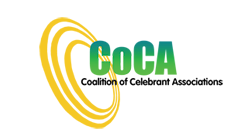Appendix 2
CoCA is concerned that the department’s 2 hours compulsory activity is very likely to lead to more confusion about the celebrant’s role and responsibilities in relation to marriage equality because the Act is not fully transparent as regards Subdivision C and D and the Marriage Celebrant and Law Section seem to focus on the letter, rather than the spirit, of the law.
Focus on Sex Identity, Gender Identity and Proof of Gender Identity
In this year’s Compulsory activity, the department stresses that marriage celebrants can require proof of gender identity by stating the following:
“Marriage celebrants may find the Australian Government Guidelines on the Recognition of Sex and Gender useful.
The guidelines are available at: https://www.ag.gov.au/RightsAndProtections/HumanRights/Pages/default.aspx “
and repeating this section about proof of gender identity under both sections titles Establishing gender and Establishing sex and gender:
“The guidelines give examples of the types of evidence Australian Government agencies accept to determine gender. Evidence suggested includes:
- a statement from a Registered Medical Practitioner or a Registered Psychologist
- a valid Australian Government travel document, such as a passport, or
- an amended birth certificate, which specifies gender.
A marriage celebrant should refuse to solemnise a marriage if they believe it may be void. If a celebrant decides not to solemnise the marriage, the celebrant should explain to the couple why they are refusing - for example, that they have concerns about the potential invalidity of the marriage.”
In addition, under Establishing gender, the department added:
If a marriage celebrant is not satisfied that the marriage forms are accurate, they should refuse to accept the NOIM. A marriage celebrant may commit a criminal offence (#) if they sign a NOIM that contains a false statement or an error, or that is defective (section 104 of the Marriage Act).
under Establishing sex and gender, the department added:
If a celebrant decides not to solemnise the marriage, the celebrant should explain to the couple why they are refusing - for example, that they are concerned the marriage form is not accurate and that if they proceed they may commit an offence.
and under Establishing sex and gender, the department noted:
It is up to each marriage celebrant to decide whether they are satisfied that the marriage forms accurately reflect each party's sex (item 4 on the NOIM) and gender (the Official Certificate of Marriage and item 2 on the NOIM). Marriage celebrants may have different views on what information will satisfy them that the marriage forms accurately reflect each party's sex and gender. Marriage celebrants can choose to accept a party's statement on what their sex and gender is(*).
If a marriage celebrant is uncertain about whether the marriage forms are accurate, the celebrant should discuss this with the couple. Marriage celebrants can ask for information from the couple that would help satisfy them that the forms are accurate.
CoCA believes it would be sufficient for the Compulsory activity to have stated “Marriage celebrants can choose to accept a party's statement on what their sex and gender is” – bold for emphasis above (* ) without the need to stress “proof of gender identity“ and reference (#) above that “marriage celebrant may commit a criminal offence”.
Focus on Gender Identity in the Ceremony
The department’s compulsory activity implies that there are only three options for the parties to the marriage describing themselves in the marriage ceremony.
The following is an extract from their Compulsory activity related to the Marriage Vows in the ceremony:
The Marriage Act sets out specific vows that must be used in civil marriage ceremonies. The vows in the Marriage Act have changed to reflect marriage equality.
The civil marriage vows now have three options for a party to use to describe the person they are marrying: namely, 'wife', 'husband' or 'spouse' [subsection 45(2) of the Marriage Act]:
I call upon the persons here present to witness that I, A.B. (or C.D.), take thee, C.D. (or A.B.), to be my lawful wedded wife {or husband or spouse).*
It is up to the marrying couple to decide which options -wife, husband or spouse- they want to use in their civil marriage vows to describe the person they are marrying. The use of these terms will be influenced by the gender identity of each party.”
This quote from the Marriage Act leaves out “or words to that effect” from section 45(2).
CoCA believes that “words to that effect” may include other options such as “marriage partner” or “partner in marriage” or “life marriage partner” and it is the authorised celebrant’s role, not the department’s, to determine what are “words to that effect”.
The current Guidelines on the Marriage Act 1961 for marriage celebrants – July 2014 Page 79 state:
• ‘family and friends’ cannot replace ‘persons here present’ or ‘everyone here’, and
• ‘partner’ cannot replace ‘husband’ or ‘wife’ or ‘spouse’.
As an example, the vows could read: ‘I ask everyone here to witness that I, A.B., take you, C.D., to be my wedded wife.’
Couples wishing to personalise their vows further are able to lengthen their vows by adding their chosen wording after saying the minimum words (so long as any material added does not contradict the minimum vows). In this sense, the minimum words are the starting point from which personalised vows can be constructed.
Given that the word “partner” is used on both the Notice of Intended Marriage and on the Official Certificate of Marriage, and the Monitum is required of all Commonwealth marriage celebrants, there can be no doubt for the couple, witnesses and guests, that even using the term “partner” or “life partner” is referring to consenting to being married (or “words to that effect” rather than “words that mean the same as”). CoCA has requested that the Registrar clarify the use of “partners in marriage” when the Guidelines are updated.
Another extract from their Compulsory activity states:
“It is important that each party to the marriage states the marriage vows accurately .
Accuracy in the marriage vows is critical to ensuring the legal validity of the marriage. A marriage celebrant who solemnises a marriage where they have reason to believe it may be void, may commit a criminal offence. Section 100 of the Marriage Act provides:
A person shall not solemnise a marriage, or purport to solemnise a marriage, if the person has reason to believe that there is a legal impediment to the marriage or if the person has reason to believe the marriage would be void.
Penalty: 5 penalty units or imprisonment for 6 months.”
CoCA is concerned that the department is misleading celebrants as to the importance of the specific wording of the vows, rather than to the intent, which is to ensure both parties to the marriage are giving free and voluntary consent.
Twenty-five per cent (25%) of all marriages (i.e. those done by Subdivision A ministers) are not required to have these specific words in the vows for the marriage to be valid according to law, and Section 45 (3) and (4) spells out the grounds upon which conclusive evidence of validity (which do not mention the vows):
(3) Where a marriage has been solemnised by or in the presence of an authorised celebrant, a certificate of the marriage prepared and signed in accordance with section 50 is conclusive evidence that the marriage was solemnised in accordance with this section.
(4) Nothing in subsection (3) makes a certificate conclusive:
(a) where the fact that the marriage ceremony took place is in issue—as to that fact; or
(b) where the identity of a party to the marriage is in issue—as to the identity of that party.”
As a result of the way this information has been presented in the Compulsory in relation to Gender Identity and the Ceremony, there is an increased risk of marrying couples taking offence at being required to answer questions about the biological sex and their gender identity now that Marriage Act has been amended to remove gender bias, and being required by an authorised marriage celebrant to describe themselves in the ceremony as one of only three possible options: bride or groom or spouse.


